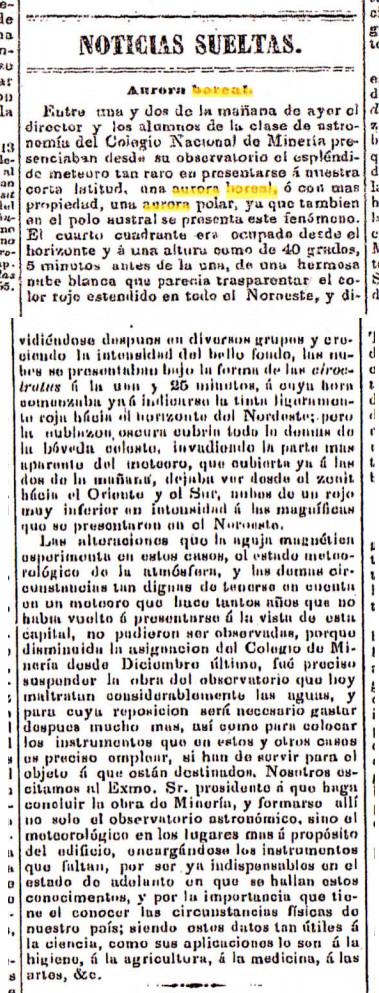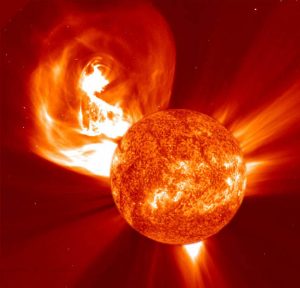25 June 2018
Found: Missing Mexican Aurora
Posted by larryohanlon
By Larry O’Hanlon
A scientist and a historian have teamed up to fill in a conspicuous hole in the story of the most intense and famous geomagnetic storm in recent history.
The Carrington Event struck on September 1, 1859, when a coronal mass ejection erupted from the Sun and struck Earth. The resulting geomagnetic storm set off a vast display of the Aurora Borealis, the Northern Lights, on September 2 that was seen as far south as Cuba and Hawaii. Those low latitudes suggest it should have been seen in Mexico as well, but little has been known about what people saw there – until now.

The top of the front page of La Sociedad, the newspaper that published several accounts of the Carrington Event aurora in Mexico. This edition carried the account posted below. Courtesy of Hemeroteca Nacional Digital de México, available in HNDM-Publicación http://www.hndm.unam.mx/consulta/resultados/visualizar/558a3aed7d1ed64f170161a0?resultado=10&tipo=pagina&intPagina=2&palabras=aurora+boreal
“In November 2016, my coauthor science historian Consuelo Cuevas-Cardona, published with her brother, astronomer Salvador Cuevas-Cardona, a paper about observations of auroras in Mexico in a non-scientific journal of history and stories of Mexico,” explained Juan Américo González-Esparza, head of the Mexican space weather service and researcher at the National Autonomous University of Mexico in Morelia, Michoacán. He is the lead author of a new study on the Mexican aurora observations in Space Weather, a journal of the American Geophysical Union.
“A friend of mine send me a link of the article and then I realized that this was the first record, to my knowledge, of the Carrington aurora in Mexico,” González-Esparza said. In the new Space Weather paper, the researchers have published the first English translations of the 159-year-old observations and brought them to the attention of the international space weather community.
Many of the observations were buried in the archives of Mexico’s La Sociedad newspaper, as was this anonymous account from Querétaro, a state in central Mexico, published on September 12, 1859:

The Aurora Borealis was observed by Professor Joaquín Velázquez de León and his students of the Mining College. This report is on page 2 of La Sociedad newspaper, September 3, 1859.
“By one o’clock in the morning of the second, the reddish light had spread towards the constellation commonly known as the Seven Goats (Pleiades). The light was seen against a background of red, which was reflected on the walls and towers of the city, illuminating the streets to a considerable degree. From the initial point where the light had appeared in the north, white streamers began to extend, not unlike those which can be observed radiating from the sun at sunset.”
La Sociedad also published reports of the aurora from Guadalajara, Hidalgo, Mexico City and Guanajuato.
“We found at least seven locations where the red aurora was observed on the night of 2 September 1859,” González-Esparza said.
As to why the reports did not make it beyond Mexico, part of the reason is that they were not in scientific journals, and so scientists outside of Mexico would not likely have seen them. Another reason was the Mexican civil was under way at the time and La Sociedad was aligned with the conservatives, who eventually lost.
“The civil war period was a very dramatic epoch for Mexico,” González-Esparza explained. “They were fighting to define the role of the Catholic church in the government. The liberals defeated to the conservatives, but in 1861, there was a French invasion and Napoleon put an Austrian emperor in Mexico (Maximiliano).” The war lasted a few more years and ended when the liberals defeated the conservatives and Maximiliano. La Sociedad ceased publishing after 1867.
The accounts of the Carrington Event are not just a historical curiosity, González-Esparza said. They are important for Mexico today.
“Before we knew this confirmation of the effects of the Carrington event in Mexico, many colleagues though that our low latitude region was immune to space weather effects,” he said. “This confirms that our country is vulnerable to intense space weather events and we need also to prepare a national strategy to prevent a Carrington like event.”

A large coronal mass ejection ejects a cloud of particles into space on 2 December 2003. It was an event similar to this, but aimed directly at Earth, which triggered the Carrington Event of 1859. Credit: SOHO (ESA & NASA)
Larry O’Hanlon is a freelance science writer, editor and social media manager. He also manages the AGU Blogosphere.



 GeoSpace is a blog on Earth and space science, managed by AGU’s Public Information staff. The blog features posts by AGU writers and guest contributors on all sorts of relevant science topics, but with a focus on new research and geo and space sciences-related stories that are currently in the news.
GeoSpace is a blog on Earth and space science, managed by AGU’s Public Information staff. The blog features posts by AGU writers and guest contributors on all sorts of relevant science topics, but with a focus on new research and geo and space sciences-related stories that are currently in the news.
Amazing the scientific knowledge that can be found anytime or anywhere. Not to mention, the fact that it can be lost to the scientific community just as easily. I’ve seen pictures, but have not experienced it directly. One day I hope to. Is there a chance that it will happen again on such a magnitude in the near future? It is unfortunate that a prediction could not be known of this magnitude, such as like Halley’s Comet or a Solar Eclipse, that it could be seen by millions personally at one time globally. =